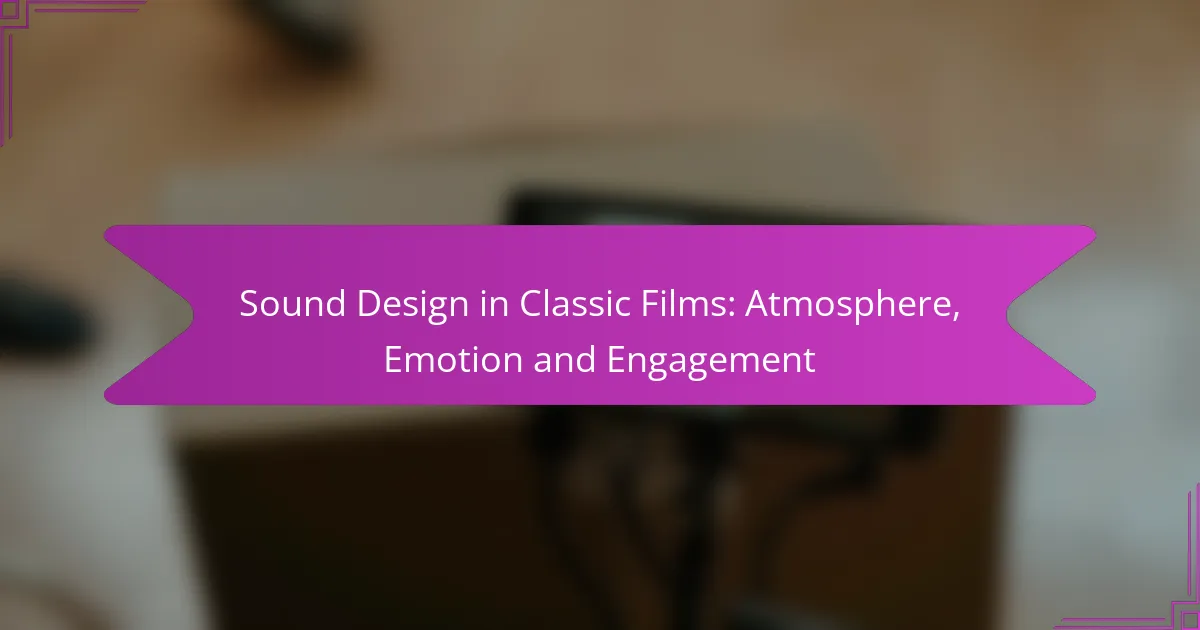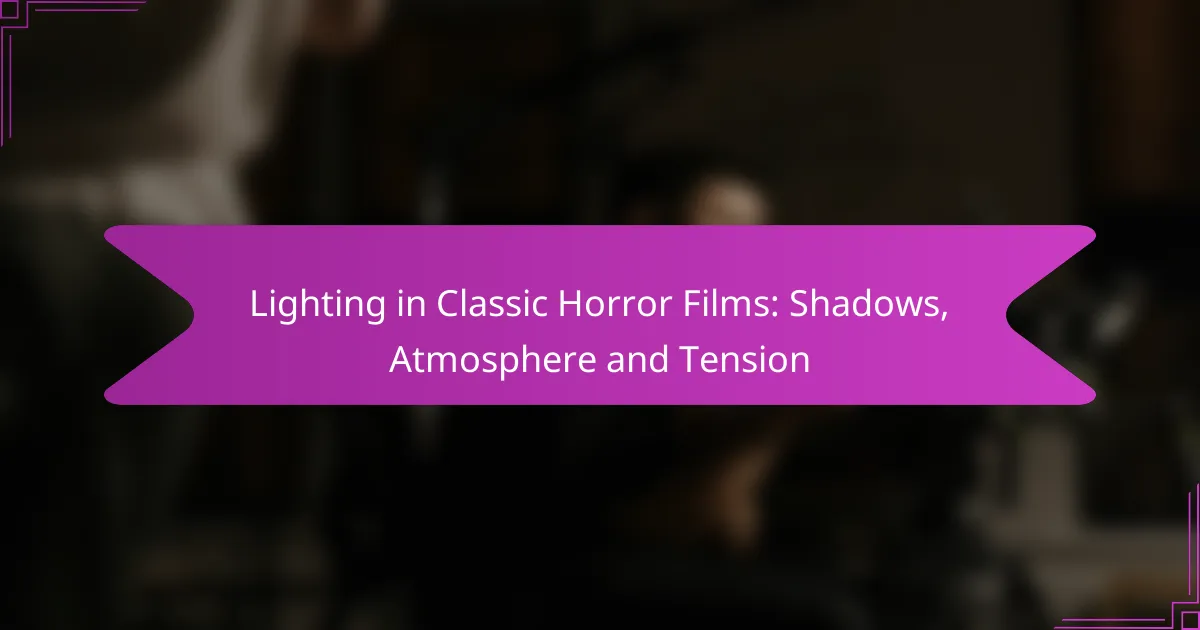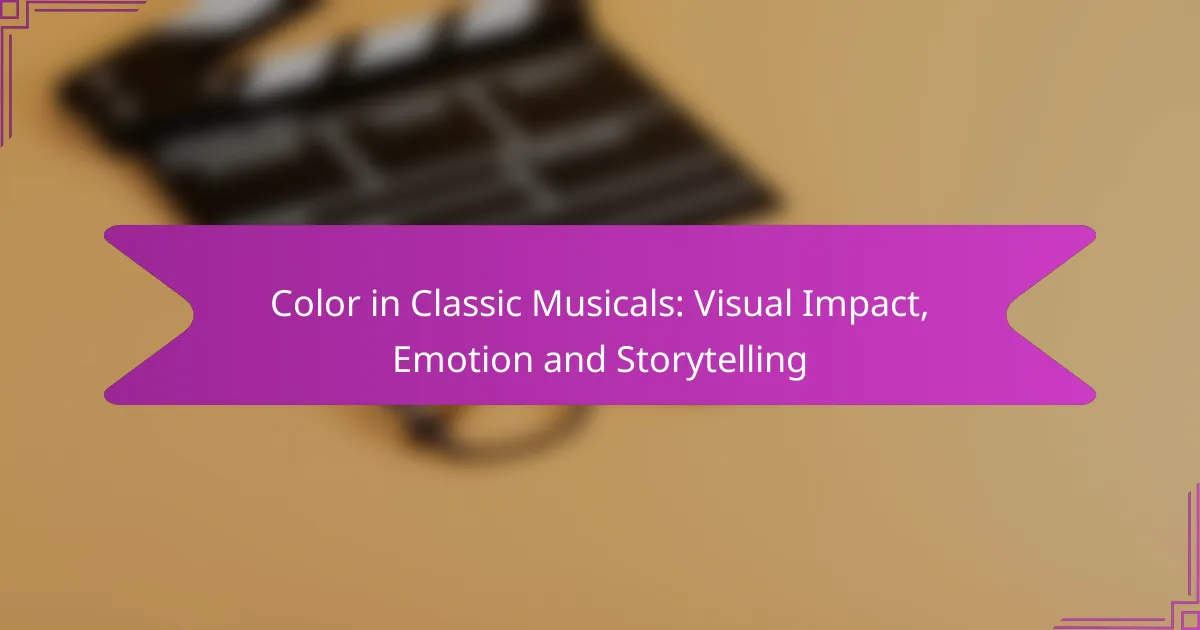Sound design plays a crucial role in classic films by crafting an immersive atmosphere that captivates audiences. By skillfully manipulating sound effects, music, and silence, filmmakers can evoke powerful emotions and enhance the storytelling experience, drawing viewers deeper into the narrative.
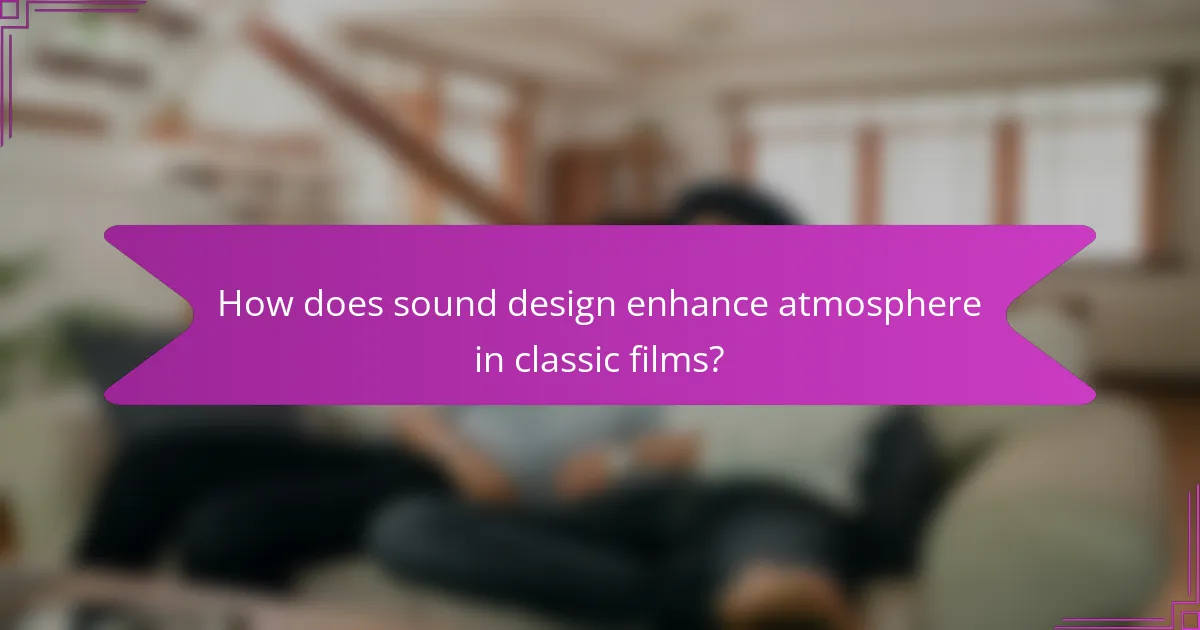
How does sound design enhance atmosphere in classic films?
Sound design significantly enhances the atmosphere in classic films by creating an immersive experience that draws viewers into the story. Through the careful selection and manipulation of sounds, filmmakers can evoke emotions, establish settings, and engage audiences on a deeper level.
Use of ambient sounds
Ambient sounds are background noises that help establish the environment within a film. These sounds can include anything from the rustling of leaves to distant city traffic, contributing to the overall mood and authenticity of a scene. For example, the subtle sounds of nature in a forest scene can create a sense of tranquility or tension, depending on the context.
To effectively use ambient sounds, filmmakers should consider the setting and the emotions they want to convey. Using a variety of ambient layers can enhance realism, but it’s crucial to avoid overwhelming the primary dialogue or action. A balanced mix ensures that the atmosphere supports the narrative without distracting from it.
Layering of sound effects
Layering sound effects involves combining multiple audio elements to create a richer auditory experience. This technique allows filmmakers to build complexity in scenes, such as layering footsteps, rustling clothing, and background chatter to make a crowded marketplace feel alive. Each layer adds depth and can influence the viewer’s perception of the scene.
When layering sound effects, it’s important to maintain clarity. Each sound should be distinct enough to be recognizable, yet harmonious with the others. Filmmakers often use equalization and panning techniques to ensure that no single sound dominates, allowing for a cohesive soundscape that enhances the film’s atmosphere.
Musical score integration
The integration of a musical score is crucial for enhancing emotional engagement in classic films. A well-composed score can underscore pivotal moments, heighten tension, or evoke nostalgia, guiding the audience’s emotional response. For instance, a sweeping orchestral score during a climactic scene can amplify the drama and impact of the visuals.
To effectively integrate a musical score, filmmakers should align the music with the film’s pacing and emotional beats. This synchronization helps create a seamless experience where the score feels like an organic part of the narrative. Additionally, using motifs or recurring themes can reinforce character development and plot progression throughout the film.
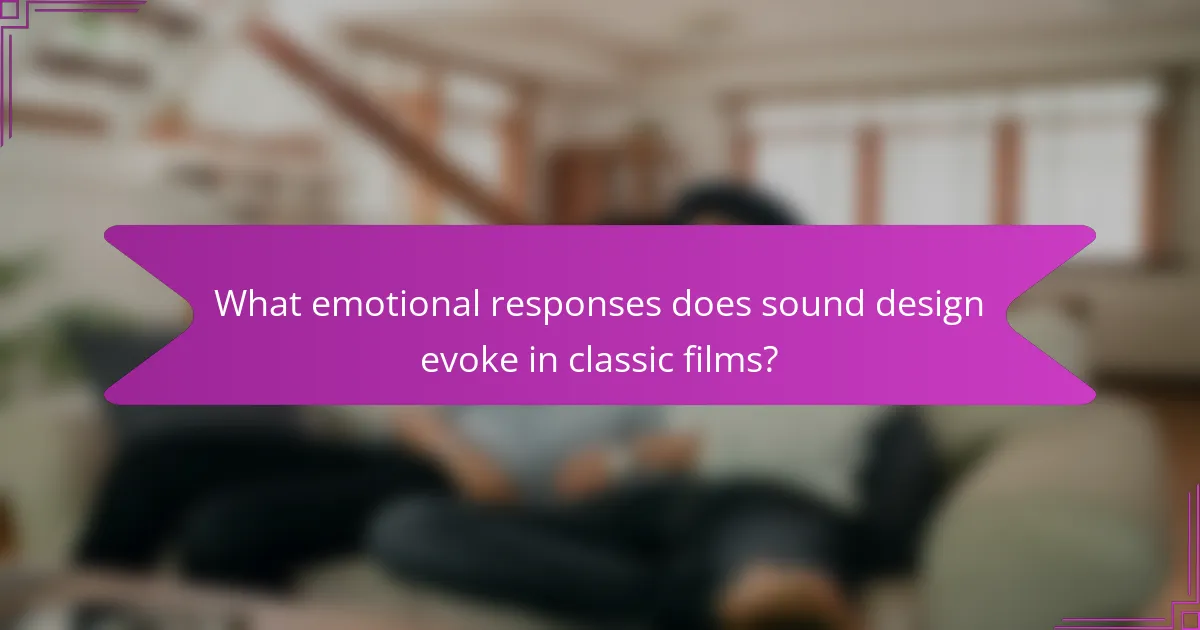
What emotional responses does sound design evoke in classic films?
Sound design in classic films evokes a range of emotional responses by enhancing the narrative and creating an immersive experience. Through the strategic use of sound effects, music, and silence, filmmakers can manipulate audience feelings, heightening tension, evoking nostalgia, or deepening empathy for characters.
Creating tension through sound
Sound design plays a crucial role in building tension in classic films. Techniques such as dissonant chords, sudden loud noises, or rhythmic patterns can create an unsettling atmosphere that keeps viewers on edge. For example, the use of staccato strings in suspenseful scenes can signal impending danger, effectively heightening the emotional stakes.
Filmmakers often employ gradual crescendos to build anticipation, allowing the audience to feel the mounting pressure before a climactic moment. A well-timed sound cue can make a scene more impactful, ensuring that viewers are fully engaged and emotionally invested.
Utilizing silence for impact
Silence is a powerful tool in sound design, often used to create dramatic pauses that amplify emotional weight. By strategically placing silence in key moments, filmmakers can allow audiences to absorb the gravity of a scene, enhancing the overall impact. For instance, a sudden drop to silence after a climactic event can leave viewers in shock, forcing them to reflect on what just transpired.
Moreover, silence can serve as a contrast to the surrounding soundscape, making subsequent sounds more pronounced and effective. This technique can evoke feelings of isolation or despair, drawing the audience deeper into the characters’ emotional experiences.
Character theme motifs
Character theme motifs are recurring musical phrases associated with specific characters, helping to evoke emotional responses and enhance storytelling. By using distinct melodies or harmonies, sound designers can signal a character’s presence or emotional state, creating a deeper connection with the audience. For example, a heroic character might have a triumphant theme that plays during pivotal moments, reinforcing their significance.
These motifs can evolve throughout the film, reflecting character development or changes in emotional state. This technique not only enriches the narrative but also allows audiences to anticipate character actions or shifts in mood, fostering a more engaging viewing experience.

How can filmmakers effectively implement sound design techniques?
Filmmakers can implement sound design techniques by collaborating closely with sound designers, utilizing advanced technology and software, and testing audience reactions. These strategies enhance the film’s atmosphere, evoke emotions, and engage viewers more deeply.
Collaboration with sound designers
Effective collaboration with sound designers is crucial for achieving a cohesive soundscape. Filmmakers should involve sound designers early in the production process to ensure that audio elements align with the film’s vision. Regular meetings and brainstorming sessions can help integrate sound creatively into the narrative.
Filmmakers should also be open to feedback from sound designers, who can provide insights on how sound can enhance storytelling. Establishing clear communication channels will facilitate a smoother workflow and allow for innovative sound solutions that elevate the film’s emotional impact.
Utilizing technology and software
Leveraging technology and software is essential for modern sound design. Filmmakers should familiarize themselves with digital audio workstations (DAWs) like Pro Tools or Logic Pro, which offer powerful tools for editing and mixing sound. These platforms allow for precise control over audio elements, enabling filmmakers to create immersive soundscapes.
Additionally, using plugins and sound libraries can enhance the creative process. Filmmakers can access a wide range of sound effects and musical scores, allowing for experimentation and refinement of the film’s audio identity. Staying updated with the latest software advancements can provide a competitive edge in sound design.
Testing audience reactions
Testing audience reactions is a vital step in refining sound design. Filmmakers should conduct screenings with diverse audience groups to gather feedback on how sound influences their experience. Observing audience responses can reveal which sound elements resonate and which may need adjustment.
Utilizing tools like surveys or focus groups can provide actionable insights. Filmmakers should pay attention to comments regarding emotional responses to sound, as this feedback can guide final edits. Iterative testing helps ensure that the sound design effectively supports the film’s narrative and engages viewers on a deeper level.

What are the key elements of sound design in classic films?
The key elements of sound design in classic films include dialogue clarity, foley artistry, and sound mixing and mastering. Each component plays a crucial role in creating an immersive atmosphere, evoking emotions, and enhancing audience engagement.
Dialogue clarity and placement
Dialogue clarity and placement are essential for ensuring that the audience can understand the characters’ lines while maintaining the film’s atmosphere. Properly recorded and mixed dialogue allows for clear communication of the story, while strategic placement in the sound field can enhance emotional impact.
To achieve optimal dialogue clarity, filmmakers often use directional microphones and soundproof environments during recording. During post-production, dialogue should be mixed at a level that balances well with background sounds and music, typically aiming for a ratio where dialogue is slightly more prominent.
Foley artistry
Foley artistry involves creating and recording everyday sound effects that enhance the realism of a film. These sounds, such as footsteps, rustling clothing, or ambient noises, are added in post-production to complement the visuals and create a more immersive experience.
Foley artists use various props and techniques to replicate sounds in sync with the film’s action. For example, using a coconut shell to mimic horse hooves or crumpling paper to simulate footsteps in the snow. This attention to detail helps transport the audience into the film’s world.
Sound mixing and mastering
Sound mixing and mastering are the final steps in sound design, where all audio elements are balanced and polished for optimal playback. Mixing involves adjusting levels, panning, and effects to create a cohesive soundscape, while mastering ensures the final product meets industry standards for volume and clarity.
During mixing, sound designers should consider the dynamic range and frequency balance to avoid muddiness or harshness. Mastering typically involves using compression and equalization to prepare the audio for various formats, ensuring it sounds good whether in theaters or on home systems.
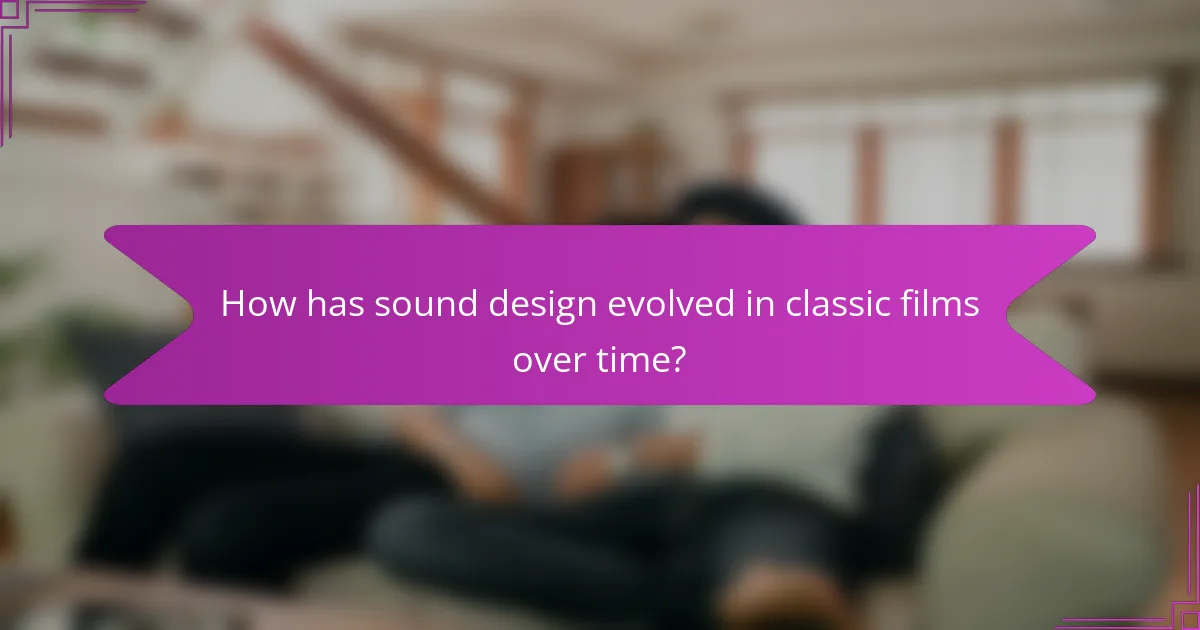
How has sound design evolved in classic films over time?
Sound design in classic films has transformed significantly, moving from simple sound effects to complex audio landscapes that enhance storytelling. This evolution reflects advancements in technology, changing audience expectations, and the shift from silent films to talkies.
Transition from silent films to talkies
The transition from silent films to talkies marked a pivotal moment in cinema history. With the introduction of synchronized sound in the late 1920s, filmmakers began to incorporate dialogue, music, and sound effects, creating a richer narrative experience.
This shift not only changed how stories were told but also how audiences engaged with films. The ability to hear actors’ voices added emotional depth and realism, making films more relatable and immersive.
Influence of technology advancements
Technological advancements have played a crucial role in the evolution of sound design. Innovations such as multi-track recording, Dolby surround sound, and digital audio editing have allowed sound designers to create intricate soundscapes that enhance the cinematic experience.
For example, the use of foley artists to create realistic sound effects has become standard practice, adding layers of authenticity to scenes. As technology continues to evolve, sound design becomes increasingly sophisticated, pushing the boundaries of what is possible in film.
Shifts in audience expectations
As sound design has evolved, so have audience expectations. Modern viewers anticipate high-quality audio that complements visual storytelling, leading filmmakers to prioritize sound design in their productions.
Today, audiences expect immersive experiences, often seeking films that utilize advanced sound techniques to create a sense of presence. This shift has prompted filmmakers to invest more in sound design, recognizing its critical role in audience engagement and emotional impact.
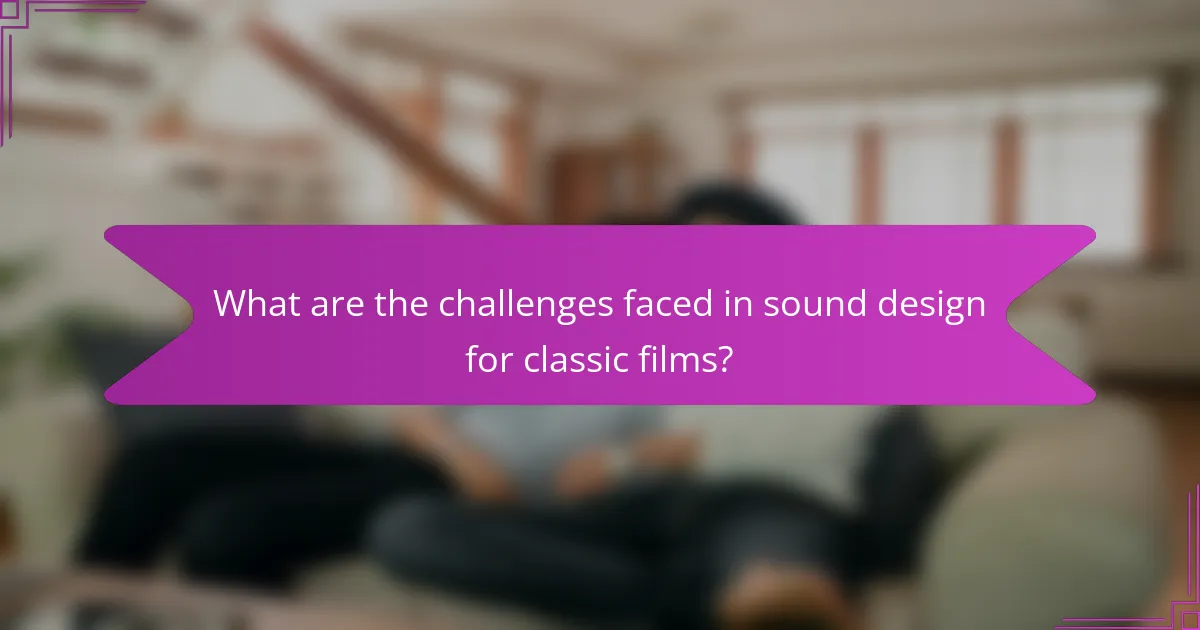
What are the challenges faced in sound design for classic films?
Sound design for classic films presents unique challenges, including the limitations of technology at the time, the need for creative storytelling, and the preservation of audio quality. Designers must navigate these factors to enhance the film’s atmosphere and emotional impact.
Technological Limitations
Classic films were often produced with rudimentary sound recording technology, which restricted the clarity and range of audio. Designers had to creatively use available tools, such as microphones and sound effects, to achieve the desired auditory experience. This often meant relying on practical effects and ambient sounds recorded on set.
For instance, in the early days of cinema, sound was recorded live during filming, making it challenging to capture dialogue without background noise. As a result, sound designers had to be innovative, using techniques like foley artistry to recreate sounds in post-production.
Creative Storytelling
Sound design plays a crucial role in storytelling, especially in classic films where visual effects were limited. Designers must carefully select sounds that complement the narrative and evoke the intended emotions. This requires a deep understanding of the film’s themes and character arcs.
For example, the use of silence can be just as powerful as sound, creating tension or emphasizing a moment. Designers often employ sound motifs that resonate with the audience, enhancing emotional engagement and reinforcing character development.
Preservation of Audio Quality
Preserving the audio quality of classic films is a significant challenge due to degradation over time. Many older films suffer from issues like hiss, crackle, or distortion, which can detract from the viewer’s experience. Restorers must utilize advanced technology to clean and enhance these audio tracks while maintaining the original character of the sound.
Techniques such as digital restoration and noise reduction are commonly used, but they require a careful balance to avoid altering the film’s authenticity. Understanding the historical context of the sound design is essential to ensure that restorations honor the original work while improving clarity for modern audiences.
